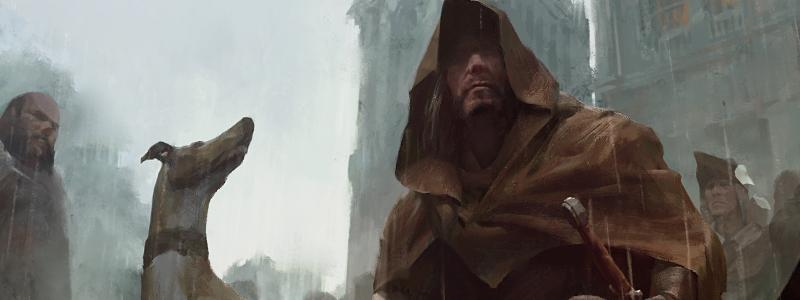Approximately one year ago, we were building the foundations of what you can see now on our KS campaign - a vision of three new standalone Chronicles of Crime games called The Millennium Series. In these short articles, I want to share with you some of the most interesting moments of creation, from the development team’s point of view.
Let’s start from the Middle Ages when we first met with our protagonist - Abelard Lavel in 1400.

Under an Umbrella
Right from the beginning we already knew that we wanted to go for three separate games instead of a new base game and expansions. We knew that we wanted to go for three different eras, spanning over a millennium. We were looking for a link, an umbrella - a place or hero, to connect all three games.
First, we started thinking about the arena of our investigations. We needed a city with a rich and long history (as we start in 1400!) and huge recognition around the world. A city that was already stunning in the middle ages, which is an icon today, and probably will be astonishing in the far future. Paris was an obvious choice!
That was the easy part done, but what about protagonists? In the original Chronicles of Crime (London Forensic), we were policemen. Not named, not famous - just ordinary cops taking care of London’s inhabitants. But in the Millennium Series, we wanted twists - both thematic and mechanical. That’s how the idea of the Lavel family was born. Members of the same family, helping to stop crime in Paris, in different eras, and in very different social roles.
Vision of Visions
The first thing that came to our minds when we started working on Chronicles of Crime: 1400 was - we need to say goodbye to the convenient “call the expert” mechanism. No more blood sample analysis done in a blink of an eye or fast research on the net. In the middle ages, we need to rely on something else, and it needs to be thematically bound to that era. The paranormal ability of our protagonist Abelard seemed great. Prophetic dreams of a non-distant future or past gave the promise of an interesting mechanical twist.

We wanted players to look at those visions as mini riddles. To make them ask questions: who is this person? What is this object? How is it connected to the case? Has it already happened? Or maybe it is something that will take place soon. Maybe we can prevent it somehow.
We loved the idea, were thoroughly excited and so, we started playtesting...
Reality of Paranormality
In our first approach, the vision cards were showing characters and items in some particular situations. For example, a lady sitting at the desk and writing a letter, with Notre Dame cathedral seen through the window behind her.
We planned that when Abelard first talks to this lady or sees the object on the vision (letter) the vision would be triggered. The app tells players to draw this particular vision card from the deck and take corresponding characters and items from the decks.
We counted on the context of the vision card giving interesting clues to the players - maybe they should look for a location near Notre Dame cathedral, maybe they should ask the lady about this letter, or try to see on the vision cards to whom she was writing.
In reality however, the way we distributed vision cards was killing the mechanism. When a vision was triggered, players simply took the listed character and item and forgot about the vision card at all. Even worse - when a vision triggered at the moment of meeting a particular character, half of the riddle was removed because the person or item which triggered the vision was already known.
Looking for Solutions
To attempt to solve this issue, we moved the visions to the very beginning of the scenario. They are not triggered when we meet someone. They are a set of our dreams from the previous night. We hoped that it would give the feeling of a visual puzzle to the players and it did just that!
However, we created another problem. With 4 or 5 vision cards at the beginning, each giving us some items and characters, we were starting a scenario with too much information to handle. It resulted in players scanning everything on everyone in the early game which was not the gameplay experience we wanted to create.
Our last solution seemed really drastic but gave us what we were looking for. We kept triggering all visions at the beginning of a scenario but got rid of the connected character and item cards completely! We kept just a few key items and introduced a new blue part of the evidence board where you keep all items you know about but do not physically possess yet.

And it worked! Sets of visions triggered at the beginning but were not overwhelming players with tons of cards from the very start, resulting in the interesting, visual puzzle we were looking for. In its final form, visions are kept on the table all time with players peeking at them and looking for any connections between them and all evidence found during the investigation.

An extra benefit is that it creates a great link between visions and Abelard’s canine companion - as soon as you get an item and move it from the blue, “idea” part of the evidence board you can give it to your doggy and he will trace the person who the item belongs to! This allowed for a new, interesting way to open up new locations in the game.
Read Part Two - Piecing Together Puzzles in The Millennium Series
Read Part Three - Jumping into Cyberspace in The Millennium Series
Filip Miłuński
Creative Director
Lucky Duck Games
